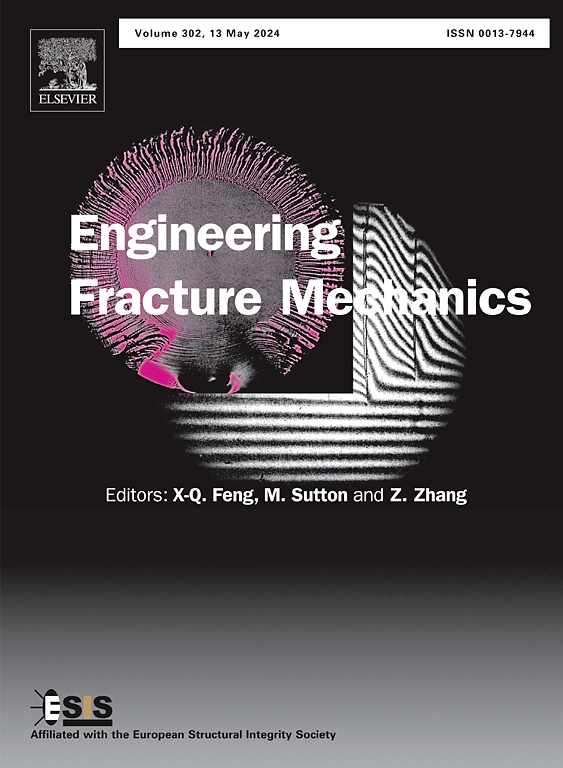Parameter identification for phase-field modeling of brittle fracture in spruce wood
IF 4.7
2区 工程技术
Q1 MECHANICS
引用次数: 0
Abstract
Understanding and predicting fracture mechanisms in complex anisotropic materials, such as spruce wood and other biological materials, is essential for structural applications requiring reliability and durability, particularly in the furniture industry. This paper presents a comprehensive two-step approach to identify the elastic and fracture/damage properties of spruce wood by combining numerical predictions from phase-field fracture simulations with experimental measurements from physical experiments. Uniaxial compression tests were conducted on 18 drilled spruce specimens, with displacement fields and critical crack initiation forces measured experimentally using Digital Image Correlation (DIC) techniques. An ad hoc phase-field model for brittle fracture, adapted to anisotropic elastic materials, was employed to numerically simulate crack initiation and propagation in spruce wood. The transversely isotropic elastic properties of spruce wood are identified using a modified Finite Element Model Updating (FEMU) method that incorporates displacement field and global reaction force measurements obtained in the linear elastic regime. The damage/fracture properties of spruce wood, in particular the critical energy release rate characterizing the fracture toughness, are determined through a classical FEMU-based optimization approach that consists of matching the experimental crack initiation forces identified from DIC residual fields and the numerical critical reaction forces predicted by phase-field simulations. The identified material parameters are consistent with values reported in the literature for spruce wood. Numerical results demonstrate the ability of the phase-field fracture model to accurately capture crack initiation forces and replicate the experimentally observed crack paths in perforated spruce specimens under compression. These findings provide valuable insights into the fracture behavior of wood and highlight the potential of phase-field modeling as a robust tool for characterizing and predicting failure in anisotropic elastic materials.

云杉木材脆性断裂相场模型参数辨识
了解和预测复杂各向异性材料(如云杉木材和其他生物材料)的断裂机制,对于要求可靠性和耐久性的结构应用至关重要,特别是在家具行业。本文提出了一种综合的两步方法,通过相场断裂模拟的数值预测与物理实验的实验测量相结合,来识别云杉木材的弹性和断裂/损伤特性。采用数字图像相关(DIC)技术对18棵云杉钻孔试件进行了单轴压缩试验,测量了位移场和临界裂纹起裂力。采用一种适用于各向异性弹性材料脆性断裂的相场模型,对云杉木材的裂纹萌生和扩展过程进行了数值模拟。采用一种改进的有限元模型更新(FEMU)方法对云杉木材的横向各向同性弹性特性进行了识别,该方法结合了在线性弹性状态下获得的位移场和全局反力测量结果。云杉木材的损伤/断裂特性,特别是表征断裂韧性的临界能量释放率,通过经典的基于femu的优化方法确定,该方法包括匹配从DIC残余场识别的实验裂纹起裂力和相场模拟预测的数值临界反作用力。确定的材料参数与文献中报道的云杉木材值一致。数值结果表明,相场断裂模型能够准确地捕捉孔洞云杉试样在压缩作用下的裂纹起裂力,并能模拟实验观察到的裂纹路径。这些发现为木材的断裂行为提供了有价值的见解,并突出了相场建模作为表征和预测各向异性弹性材料破坏的强大工具的潜力。
本文章由计算机程序翻译,如有差异,请以英文原文为准。
求助全文
约1分钟内获得全文
求助全文
来源期刊
CiteScore
8.70
自引率
13.00%
发文量
606
审稿时长
74 days
期刊介绍:
EFM covers a broad range of topics in fracture mechanics to be of interest and use to both researchers and practitioners. Contributions are welcome which address the fracture behavior of conventional engineering material systems as well as newly emerging material systems. Contributions on developments in the areas of mechanics and materials science strongly related to fracture mechanics are also welcome. Papers on fatigue are welcome if they treat the fatigue process using the methods of fracture mechanics.

 求助内容:
求助内容: 应助结果提醒方式:
应助结果提醒方式:


